The Future of Learning: Brain Plasticity Innovations
Introduction
As we journey through the 21st century, the paradigms of education and learning continue to evolve drastically. Advances in neuroscience have unveiled a captivating aspect of our minds: brain plasticity, the capability of the brain to change and adapt as a result of experience. This remarkable quality—once thought to be limited to childhood—has opened up new horizons for understanding how we learn and grow throughout our lives. In this post, we will explore the significance of brain plasticity, recent innovations, and the future of learning.
Understanding Brain Plasticity
What is Brain Plasticity?
Brain plasticity, or neuroplasticity, refers to the brain's ability to reorganize itself by forming new neural connections throughout life. It allows the brain to adjust its activities in response to new situations or to changes in the environment. This adaptability is crucial for several processes including:
- Learning and Memory: Learning is linked to the brain's ability to change structurally and functionally as a result of new information.
- Recovery from Injury: Neurological rehabilitation strategies leverage plasticity for recovery of functions after brain injuries.
- Developmental Changes: The brain undergoes significant structural changes during critical periods in child development, which are influenced by learning experiences.
Types of Brain Plasticity
There are two primary types of brain plasticity:
- Structural Plasticity: Involves changes in the physical structures of the brain, including synaptic connections and the growth of new neurons (neurogenesis).
- Functional Plasticity: Refers to the brain's ability to shift functions from damaged areas to undamaged areas, particularly relevant following brain injuries or strokes.
Innovations Driven by Brain Plasticity Research
1. Personalized Learning Environments
Recent advances in technology and neuroscience have led to the development of personalized learning platforms that cater to individual differences in learning styles. By analyzing data related to how the brain responds to various stimuli, educational technologies can better adapt content to maximize engagement and retention. Personalized learning seeks to leverage neuroplasticity, ensuring that every learner’s unique pathways are acknowledged and strengthened.
2. Neurofeedback Techniques
Neurofeedback, a type of biofeedback, is gaining traction as an innovative tool to enhance learning processes. Utilizing real-time feedback on brain activity, learners can actively train their brains to improve focus, memory, and other cognitive functions. This technique capitalizes on brain plasticity by encouraging self-regulation and the reinforcement of neural pathways associated with optimal learning states.
3. Benefits of Multisensory Learning Approaches
The incorporation of multisensory learning strategies—engaging multiple senses in the learning process—has shown significant promise in enhancing brain plasticity. Research indicates that learning that engages sight, sound, touch, and movement can lead to deeper understanding and retention of information. This holistic approach stimulates various areas of the brain, fostering new connections and strengthening existing ones.
4. Gamification of Learning
Gamification introduces game-like elements into non-game contexts, and it has proven to enhance motivation and engagement in learning. This approach not only makes learning more enjoyable but also promotes neural engagement and encourages the reinforcement of learning pathways. The elements of competition, rewards, and achievement can be highly effective in tapping into the brain's plastic capabilities.
The Future of Learning: Implications of Brain Plasticity Innovations
1. Lifelong Learning Paradigm
With the insights gained from brain plasticity research, the concept of lifelong learning is evolving. The traditional notion of education confined to childhood or young adulthood is becoming obsolete. Instead, adults are encouraged to engage in continuous learning experiences throughout their lives. This shift emphasizes that learning is an ongoing process that can occur at any age, fostering intellectual growth and adaptability.
2. Focus on Mental Health and Well-being
Innovations in understanding brain plasticity have significant implications for mental health. As we learn more about the relationship between learning, emotional resilience, and neuroplasticity, educational systems may increasingly incorporate mental health resources. Understanding that addressing cognitive and emotional challenges can lead to improved learning outcomes allows for a holistic approach to education.
3. Reimagining Educational Institutions
The continued exploration of brain plasticity fuels a rethinking of traditional educational frameworks. Schools and universities may evolve into environments that prioritize experiential learning, collaborative projects, and problem-based learning. As we move further into a knowledge-driven society, the emphasis will be on teaching students how to think critically and adaptively rather than rote memorization of facts.
4. Integration of Technology
The role of technology in education will undoubtedly grow, especially with advancements in artificial intelligence (AI) and virtual reality (VR). These tools can create enriched learning environments that better simulate real-life experiences and promote active engagement. Technologies that assist in fostering cognitive and emotional development will play a vital role in shaping the future of education.
Conclusion
The exploration of brain plasticity and its implications for learning is still in its infancy, yet the potential is undeniably transformative. As researchers unlock more secrets of the brain, understanding how to leverage these insights could redefine how knowledge is imparted and absorbed. The future of learning will likely be characterized by personalized, engaging approaches that account for individual differences in neural wiring and cognitive processing.
Fostering a mindset that embraces adaptability and lifelong learning could lead not only to more effective educational strategies but also to a society that values curiosity and continuous growth. As we harness the power of brain plasticity, one thing is clear: the journey of learning is an adventure that knows no bounds.
Let’s keep the conversation going! How do you envision the future of learning in light of these innovations? What changes would you like to see in the education system? Feel free to share your thoughts and insights in the comments!
Harness the Power of Neuroplasticity
Discover Peak Brain Plasticity, a practical book to harnessing neuroplasticity. Enhance your memory, learn new languages quickly, and alleviate anxiety with effective study methods. Uncover daily habits that impact cognitive health and explore techniques for accelerated learning and memory retention. Unlock your brain's potential for growth and transformation.
